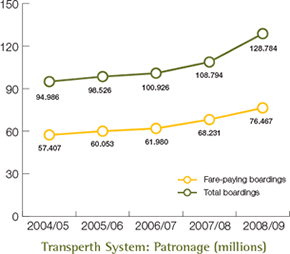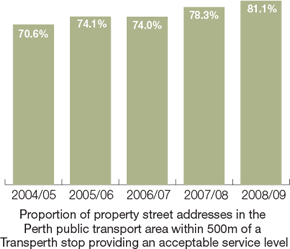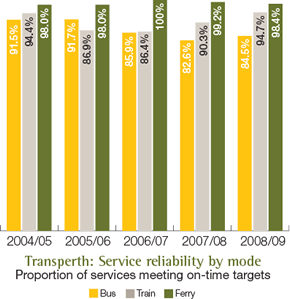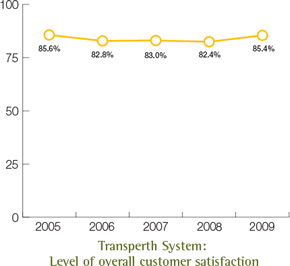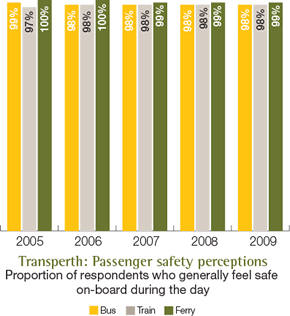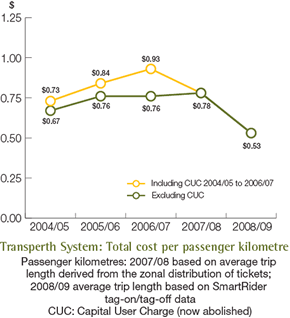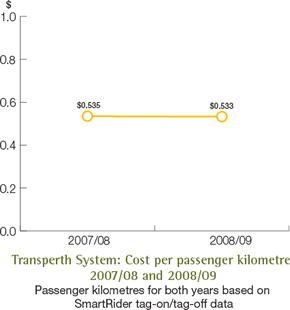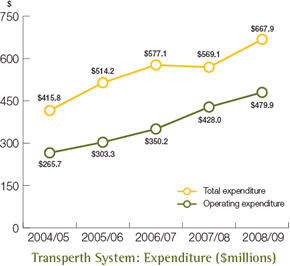Transperth
Transperth is the brand and operating name of the fully-integrated public transport system in the greater metropolitan area of Perth.
The Transperth system consists of an extensive bus network, a fully-electrified urban train system and a ferry service. The system is managed by the Transperth branch of the Transperth System, Regional and School Bus Services division, which provides overall management of the Transperth system, including functions such as system planning and ticketing. The division also contract-manages key functions including bus service delivery and bus fleet procurement.
Transperth bus and ferry services are provided under commercial contract arrangements, while Transperth train services are provided by the PTA’s Transperth Train Operations (TTO) division.
Passenger information is provided through information offices and a call centre. The Perth Station information office is operated by TTO, while all other Transperth information offices are operated by Transperth contractor Serco.

|
OBJECTIVE |
OUTCOME |
|---|---|
|
Continue the installation of the Recording and Passenger Information Dissemination System (RAPID). |
Installation completed. |
|
Continue work on the underfloor railcar wheel lathe at Nowergup Depot. |
All work on the wheel lathe and associated infrastructure completed. |
|
Encourage the use of public transport for special events. |
Major events are now typically joint-ticketed. |
|
Continue to pursue patronage growth, high passenger satisfaction, and a high level of on-time running. |
Continuing the trend of the past nine years, fare-paying boardings on the Transperth system increased by 12.1 per cent while total boardings rose 18.4 per cent. The level of overall customer satisfaction with Transperth (averaged over all modes) increased to 85.4 per cent from 82.4 per cent in 2008. On-time running (OTR) on both bus and train services recorded a significant improvement. |
Key service measures
Patronage and services provided
Patronage on the Transperth system continued to record excellent growth. Total boardings increased 18.4 per cent from 108.794 million in 2007/08 (when the Mandurah Line was in operation for fractionally more than six months) to 128.784 million. Fare-paying boardings rose 12.1 per cent from 68.231 million to 76.467 million.
From 4 April 2009, WA seniors and aged and disability pensioners were allowed free travel on weekdays from 9am to 3.30pm and all day Saturdays. The previous free travel entitlement on Sundays and public holidays, which had applied only to WA seniors, was also extended to aged and disability pensioners. During the three months to end-June 2009, this free travel entitlement resulted in approximately 1.6 million total boardings.
Passenger place kilometres also increased substantially. This metric is based on service kilometres and the average capacity of the fleet, and represents the total passenger carrying capacity provided by the Transperth bus, train and ferry network.
Following an increase of 25 per cent from 6595.7 million to 8243.3 million in 2007/08, total system passenger place kilometres recorded a further increase of 13.3 per cent to 9337.0 million in 2008/09. In the five-year period from 2004/05 total capacity provided on the Transperth system has jumped by nearly 60 per cent.
This substantial increase was almost entirely due to the expansion of the Transperth train network. The extension of the rail network to Clarkson and Thornlie, the introduction into service of three-car and six-car trains and the increase in service kilometres following the start of services on the Mandurah Line resulted in train passenger place kilometres more than doubling from 2293.6 million in 2004/05 to 4600.8 million in 2007/08. In 2008/09, following the introduction of new services and an increase in service kilometres, train passenger place kilometres recorded a further increase of 22.6 per cent to 5641.3 million.
The contribution of the bus network to growth in system passenger carrying capacity was relatively modest. In 2008/09, bus passenger place kilometres increased by 1.5 per cent.
Access to public transport
The above graph shows that a very high proportion of property street addresses (PSAs) in Perth are within walking distance (500m) of a Transperth stop providing an acceptable service level (ASL). An ASL is defined as a service every 20 minutes or less in the peak flow direction during the peak, and at least hourly throughout the core of the day.
Transperth uses a Global Positioning System (GPS) to measure the level of accessibility to public transport facilities. GPS identifies the exact location of all bus stops and train stations and enables accessibility to these facilities to be measured against other spatial data - in this case PSAs.
The proportion of PSAs within 500m of a stop providing an ASL remained static between 2005 and 2007, and then increased by 5.8 per cent to 78.3 per cent in 2007/08 and a further 3.6 per cent to 81.1 per cent in 2008/09. Over the five-year period between 2005 and 2009, the proportion of PSAs with access to Transperth facilities providing an ASL increased by nearly 15 per cent. This improvement reflects the expansion of the feeder bus network in the southern suburbs following the introduction of the Mandurah Line.
The number of Transperth boarding points (bus stops and train stations) with an ASL, recorded an increase of 8.7 per cent in 2008/09 to 7279.
Reliability
Reliability of Transperth bus and ferry services (OTR or on-time running) is monitored for bus and ferry services by using the GPS reporter functionality of the SmartRider system, and for trains is recorded through the train control system. These technology-based methods allow more precise data-gathering than the physical checks previously used for buses and ferries, and the manual observations and recordings by train control staff.
In 2008/09, both bus and train recorded significant improvements in service reliability while there was a small reduction in ferry OTR.
Passenger satisfaction
An independent market research firm commissioned by Transperth carries out the annual Passenger Satisfaction Monitor (PSM) to assess the level of satisfaction/dissatisfaction among passengers with various aspects of Transperth services. The above graph shows the proportion of respondents who expressed overall satisfaction with the level of service on Transperth bus, train and ferry services, calculated as a weighted average across all modes. Following a relatively static level of satisfaction between 2006 and 2008, a significant improvement was recorded in 2009 when 85.4 per cent of users across the system expressed overall satisfaction with the level of service provided on Transperth services.
Passenger safety perceptions
Note: Measures relating to customer perception of safety at other times and at stations/interchanges are shown in sections dealing with individual modes.
The PSM assesses customer perceptions of safety during the day and at night, on board buses, trains and ferries, and at bus and train stations and ferry jetties. The graph shows that nearly all passengers feel safe aboard Transperth buses, trains and ferries during the day.
Efficiency
Passenger kilometres are calculated by multiplying the number of initial boardings by the average trip length. Because of a change in the method of determining average trip length, which resulted in a significant increase in passenger kilometres, total cost per passenger kilometre fell 31.8 per cent, from $0.78 to $0.53.
Until 2007/08, the average trip length for bus and train was calculated using the zonal distribution of ticket sales. However, this method provided only a rough estimate of average trip length because the previous ticketing system did not identify start and finish details for each trip. It also did not report on transfers and therefore understated passenger kilometres.
In 2008/09, a more precise basis was used to determine the average trip length for bus and train based on SmartRider data. SmartRider users are required to tag on and tag off when boarding and alighting from a Transperth vehicle. This process accurately shows the length of each journey leg for SmartRider users, including free travel for which the use of a SmartRider is required (e.g. free travel by seniors/pensioners, PTA free pass), and transfers. This data is used to calculate the average trip length on bus and train per initial boarding and per transfer.
Passenger kilometres for SmartRider users is the sum of SmartRider initial boardings multiplied by the average trip length for initial boardings and the SmartRider transfer boardings multiplied by the average trip length for transfers. Assuming that the behaviour of cash passengers mirrors that of SmartRider passengers, the average trip lengths calculated for SmartRider initial boardings and transfers were applied to cash initial boardings on bus and train (cash fare-paying boardings plus free passes recorded on bus ticket issuing machines), and cash transfers to calculate passenger kilometres for cash passengers.
Estimated trip lengths were applied to boardings on Free Transit Zone (FTZ) services in Perth and to boardings on Central Area Transit (CAT) services in Perth, Fremantle and Joondalup to calculate passenger kilometres for boardings on these services.
In 2007/08, system-wide passenger kilometres based on average trip length derived from the zonal distribution of tickets amounted to 728.2 million compared to 622.2 million in 2006/07, an increase of 17 per cent. This increase was due to the extension of the rail network to Mandurah and consequent increase in train trip length and initial boardings (during the latter part of the year).
However, based on the more accurate trip data now available (using average trip length derived from SmartRider tags), passenger kilometres were actually 1064.7 million in 2007/08, rising 17.7 per cent to 1252.9 million in 2008/09. Of total passenger kilometres in 2007/08, bus accounted for 47.4 per cent, train for 52.5 per cent and ferry for 0.1 per cent. In 2008/09, bus passenger kilometres fell four per cent from 504.6 million in 2007/08, to 484.6 million and the bus share of total passenger kilometres declined to 38.7 per cent. Train passenger kilometres increased 37.2 per cent from 559.5 million to 767.6 million and trains’ share of total passenger kilometres increased to 61.3 per cent.
The reduction in the bus share of total passenger kilometres in 2008/09 reflects the loss of long-distance trips in the southern suburbs following the introduction of the Mandurah Line. These bus trips were replaced by short feeder trips to train stations, which accounts for about 30 per cent of total boardings on the Mandurah Line. Many passengers in the southern suburbs can now either walk to the station or use Park ’n’ Ride. The higher share of passenger kilometres that trains accounted for in 2008/09 resulted from the increase in fare-paying boardings due to the Mandurah Line and, given the longer distances on this line, an increase in the average trip length on the train network.
The following graph shows average cost per passenger kilometre for 2007/08 and 2008/09 using passenger kilometres based on average trip length derived from SmartRider data.
While passenger kilometres (based on SmartRider data) increased by 17.7 per cent in 2008/09, total costs rose 17.4 per cent. Consequently, the average cost per passenger kilometre fell marginally by 0.3 per cent from $0.535 to $0.533.
Expenditure and revenue
In 2008/09, total expenditure increased by 17.4 per cent to $667.9 million from $569.1 million while operating expenditure (i.e. excluding interest and depreciation) increased 12.1 per cent to $479.9 million from $428 million. Across the modes, bus total costs increased by 11.5 per cent and operating costs by 12.7 per cent, train total costs increased 22.9 per cent and operating costs by 11.6 per cent and ferry operating costs increased by 4.2 per cent while total costs fell by 19.6 per cent due to interest and depreciation. The system total cost increased in 2008/09 for several reasons.
- Annual interest and depreciation on train services increased by 46.9 per cent resulting in system capital charges recording an increase of 33.2 per cent. Bus capital charges rose 5.7 per cent.
- Bus driver wages rose 9.7 per cent.
- The full-year impact of operations on the Mandurah Line.
- Higher fuel and energy costs
System-wide revenue continued to record significant growth. In 2008/09, fare revenue and total revenue increased by 16.1 per cent. This growth in revenue followed respective increases of 25.4 per cent and 26.6 per cent in fare-paying revenue and total revenue in 2007/08.
Fare revenue includes funding for the Perth CAT service and contributions for specific bus services paid to Transperth in lieu of fares, while total revenue takes into account, in addition to fare revenue, such income as advertising, rent, infringements etc. The increase in fare revenue was due to the significant growth in system fare-paying boardings (12.1 per cent) and higher fares (an overall average increase of 2.7 per cent compared to 2007/08).
Review of performance
Service reliability
In January 2007, Transperth changed its method of gathering data to measure service reliability. More precise technology-based methods replaced the staff-based assessments used previously and this resulted in a significant impact on outcomes in 2007/08. The results for 2008/09 show a marked improvement over 2007/08.
Trains
The target for TTO in 2008/09 was for 95 per cent of services to arrive within four minutes of the scheduled time. The result was 94.7 per cent of services meeting the target compared with 90.3 per cent in 2007/08.
In 2007/08 considerable service delays were caused by work on the Mandurah Line. Following the completion of this work, TTO was able to achieve a significant improvement in train service reliability in 2008/09. It should be noted that up to 2006/07, the on-time target for train operations was for 95 per cent of trains to arrive within three minutes of the scheduled time. The target was changed in 2007/08 to take account of longer rail services with increased journey times, and also to ensure consistency in reliability measures across Transperth’s train operations and other Australian rail operators.
Buses
The service reliability target for Transperth buses is to never depart from a terminus or travel through a mid-way timing point early, and for 85 per cent of services to arrive within four minutes of the scheduled time.
Since 2007/08 Transperth has used the GPS reporter functionality of the SmartRider system to monitor bus reliability. Monitoring is based on a random sample of one per cent of trips in each of the bus contract areas (a substantial number, given that there are more than 10,000 bus trips on a typical weekday). The use of this precise measure provides an accurate picture of bus on-time performance. No other public transport jurisdiction in Australia has the technology and capacity to provide this precise level of automated checking of bus services.
In 2008/09, Transperth buses moved close to achieving the reliability target of 85 per cent when 84.5 per cent of services operated within the four-minute tolerance period, compared with 82.6 per cent in 2007/08. The improved performance was helped by the completion of Mandurah Line works, which eased general traffic congestion as well as works-related congestion and helped to avoid delays. Additionally, a significant number of bus services in the Canning, Fremantle-Cockburn and Rockingham-Mandurah contract areas have now become feeder services to train stations and operate in suburban areas rather than as CBD-centric routes, again reducing the congestion impact.
Ferries
The target for Transperth ferries is for services to arrive within three minutes of the scheduled time. In 2008/09, using GPS tracking to run the checks, 98.4 per cent of services met the reliability target, compared with 99.2 per cent in 2007/08. This reduction in the level of reliability was due to two trips out of the 124 trips checked during the year being late.
Trends in patronage
Patronage on the Transperth system increased for the tenth year in succession. The exceptional growth rate on the train network following the start of services on the Mandurah Line continued in 2008/09.
Total boardings (comprising fare-paying boardings, free travel and transfers) on the Transperth system increased 18.4 per cent, from 108.794 million in 2007/08, to 128.784 million. Initial boardings (which exclude transfers) increased by 13.5 per cent to 91.456 million, while fare-paying boardings (which exclude free travel and transfers) increased 12.1 per cent to 76.467 million. The rates of increase achieved in 2008/09 significantly exceeded those of 2007/08, when total boardings increased by 7.8 per cent, initial boardings by 8.5 per cent, and fare-paying boardings by 10.1 per cent.
The significant impact of the Mandurah Line can be seen in a like-for-like comparison of patronage during the six-month period January to June in 2008 and 2009. During this period, system-wide total boardings increased by 9.8 per cent, initial boardings by 7.6 per cent and fare-paying boardings by 3.9 per cent.
All cash and SmartRider fare-paying boardings are recorded accurately on the Transperth ticketing system. During 2008/09, on average, passengers using SmartRider accounted for 66.1 per cent of passenger boardings compared with 61.9 per cent in 2007/08. In addition, the SmartRider system allows transfers to be accurately recorded and this data provides a model of passenger behaviour to estimate transfers for cash passengers.
In longer-term trend analysis, over the period 2004/05 to 2008/09, total boardings on the Transperth system increased by 35.6 per cent, while fare-paying boardings rose 33.2 per cent. During this period, total boardings on buses increased at an average annual rate of 4.4 per cent, and on trains at an average annual rate of 13.8 per cent. The average annual rate of increase in fare-paying boardings during the period was 2.8 per cent for bus and 14.8 per cent for train. Patronage on the Transperth ferry service, which had achieved significant gains in 2005/06 and 2006/07, fell sharply in 2007/08 with total boardings declining by 15 per cent and fare-paying boardings by five per cent. In 2008/09, total boardings on ferry increased by 4.3 per cent (due to more accurate recording of transfers) while fare-paying boardings fell 4.6 per cent.
Total capacity provided on the Transperth system expressed in terms of passenger place kilometres continued to increase. In 2008/09, Transperth provided total capacity amounting to 9337 million passenger place kilometres compared with 8243.3 million in 2007/08.
On a per-capita basis, public transport usage within the Perth metropolitan area (including the City of Mandurah) increased from 49.7 initial boardings per capita in 2007/08 to 54 initial boardings per capita in 2008/09, an 8.7 per cent increase compared with an increase of 4.5 per cent in the estimated population.
Marketing of the service
In 2008/09, the Transperth team successfully undertook the following initiatives:
- The 136213 SMS service, a new service which allows passengers to SMS their stop number to 13 62 13 and receive the next few services departing from that stop, was launched. SmartRider balances can also be checked using this service.
- Two new services were introduced - Route 79 to QEII Medical Centre and the University of Western Australia, and Route 407 between Herdsman Business Park and Glendalough Station - and improvements made to shoulder-of-the-peak bus services in the northern suburbs.
- The community education team continued to deliver Get on Board presentations to a broad range of community groups, including seniors, people with disabilities, migrants and school children, to help them understand how the Transperth system works, and to encourage the use of public transport.
- An awareness campaign was run to provide WA Seniors and aged and disability pensioners information on their new free travel entitlements.
- The team continued to work with major sporting organisations as well as event organisers, to ensure that adequate public transport services are planned and funded when developing special events throughout the Perth metropolitan region.
- A large-scale information exercise was carried out to ensure that existing users of Transperth services were aware of the changes on 28 June 2009, to accommodate the removal of W pattern services on the Joondalup and Mandurah Lines in off-peak periods, as well as changes to Fremantle and Midland Line services.
Disability access
Transperth aims to provide universal access to its bus, train and ferry system, so that the wider community (including people with disabilities and parents with prams) can access services and facilities. In 2008/09, further progress was made towards achieving this objective, as reflected below.
Trains
All Transperth trains are universally accessible. The key accessibility issue for train services is whether access to the train station is provided for people with varying disabilities and whether the gap between train and platform meets accessibility standards. Currently, 36 out of 70 train stations, (51.4 per cent) provide independent access to people with disabilities and parents with prams. At the other stations, passengers are assisted by PTA customer service staff when required.
|
INDEPENDENT ACCESS* |
PARTIAL ACCESS** |
LIMITED ACCESS** |
TOTAL STATIONS |
|
|---|---|---|---|---|
|
2004/05 |
15 |
31 |
12 |
58 |
|
2005/06 |
16 |
31 |
12 |
59 |
|
2006/07 |
23 |
26 |
10 |
59 |
|
2007/08 |
34 |
25 |
10 |
69# |
|
2008/09 |
36 |
25 |
9 |
70# |
* Complies with the Disability Standards for Accessible Public Transport and Guidelines under the Disability Discrimination Act, 1992
** Assistance available from Transperth customer service staff
# Perth Underground Station included in Perth Station in 2007/08, identified as a separate station in 2008/09.
Buses
Transperth continued its long-term program of increasing the number of accessible buses in its fleet with the purchase of 82 new low-floor accessible Compressed Natural Gas (CNG) powered buses as part of the Daimler Chrysler bus supply agreement. As at 30 June 2009, the number of accessible buses was 774 out of a total fleet of 1134 (68.3 per cent) compared with 686 out of a total fleet of 1124 buses (61 per cent) at 30 June 2008.
Preference is given to operating accessible buses whenever possible so that in off-peak periods most of the buses in service are accessible. During peak periods, when service demand is high, both accessible and non-accessible buses are fully committed. Accessible buses accounted for 76.6 per cent of service kilometres in 2008/09, up from 70.8 per cent in 2007/08.
During the year, 16 diesel low-floor buses were transferred to regional towns as part of the State’s public transport system managed by the PTA. The PTA has a responsibility to ensure that the bus fleets in regional towns meet the Federal legislated requirement in regard to accessibility. To replace these 16 buses, 16 new CNG buses were procured for the Transperth fleet. The buses transferred to regional towns in 2008/09 form part of a program to transfer 41 buses to regional areas over a four-year period.
Transperth continued its program of upgrading accessibility at bus stations and bus/train interchanges to meet the requirements of the Federal Disability Standards for Accessible Public Transport. During the year, work was carried out to completely refurbish Kalamunda bus station to meet all accessibility standards.
Ferries
During the year, the bulk of Transperth ferry services were provided by the MV Shelley Taylor-Smith, an accessible vessel. The second ferry used for limited services, the MV Countess II, was replaced by a new accessible ferry, the MV Phillip Pendal, on 3 May 2009. This new vessel will now become the primary vessel for Transperth ferry services. The two jetties used for Transperth ferry services during the year - Barrack Street in Perth and Mends Street in South Perth - meet the Federal Disability Standards for Accessible Public Transport.
Service coverage
Transperth aims to maximise the number of people in the community who have ready access to its services. Service coverage is measured in terms of the proportion of PSAs within the Perth Public Transport Area that are less than 500m from a Transperth stop (bus, train, or ferry) providing an ASL.
In 2008/09, the proportion of PSAs within 500m of an ASL stop rose 3.6 per cent to 81.1 per cent compared with 78.3 per cent in 2007/08. The number of stops with an ASL increased 8.7 per cent from 6698 to 7279.
Passenger satisfaction
Transperth’s annual customer survey, the PSM, showed that in 2009, on a system-wide basis, 85.4 per cent of survey respondents expressed overall satisfaction with the level of service compared with 82.4 per cent in 2008. (Details of passenger satisfaction with train, bus and ferry services are included in individual mode reports.)
SmartRider project and system ticketing
While other major Australian cities are moving towards a smartcard-based ticketing product, Transperth’s SmartRider ticketing system continues to improve on its success. In June 2009, SmartRider accounted for 68.7 per cent of fare-paying boardings on bus, 72.1 per cent on train, and 31.8 per cent on ferry compared with 65.1 per cent, 68.3 per cent, 32.3 per cent respectively in June 2008.
On an annual basis in 2008/09, SmartRider accounted for an average of 66.1 per cent of fare-paying boardings for the system as a whole, with the share in each mode as follows - bus 65.4 per cent, train 67.3 per cent, and ferry 30 per cent.
During the year, SmartRider was introduced on public transport services in Geraldton, approximately 400km north of Perth, making it the first regional town in Australia to have access to a smartcard-based ticketing product. Residents of Geraldton and Perth can now use their SmartRider when using public transport in these areas.
SmartRider is also used to provide access to off-peak free travel for WA seniors and aged and disability pensioners. This entitlement, which came into effect on 4 April 2009, allows eligible passengers free travel on weekdays from 9am to 3.30 pm, and all day on weekends and public holidays. The introduction of this free travel entitlement marks another first for Western Australia.
Transperth also completed installation of the state-of-the-art cash ticket vending machines (TVMs) at all train stations and ferry terminals, providing occasional users with a cash ticket alternative if they do not have a SmartRider.
Transperth can now boast of having the most successful integrated ticketing system in Australia.
